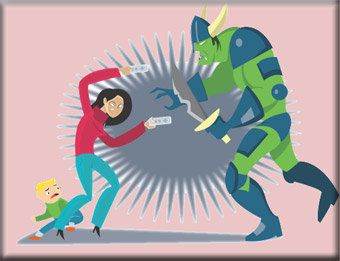How much should we worry about the daily dose of interactive, virtual murder and mayhem in our kids’ lives?
Video games first came to an arcade or home near yours in 1972 with the likes of Pong and Odyssey. By the early 1990s these tiddlywinks games had been replaced by richly interactive and violent games like Mortal Kombat and Wolfenstein.
A decade later kids were playing these games 5 to 13 hours a week. Today young people in America spend more time playing video games than watching movies, and last year’s most notorious video game, Grand Theft Auto IV, sold 6 million copies in its first week, earning more than half a billion dollars.
The runaway popularity of video games can be attributed to leapfrogging computer technology, which has produced amazingly realistic and sophisticated games, introducing players to lavishly intricate worlds with multilayered storylines, complex characters, and increasingly stunning special effects. But these games are also selling like hotcakes because they are fun, challenging, engaging, and addictive. Each new generation offers gamers bigger and better obstacles to overcome and more exciting opportunities to master skills and vanquish opponents. So what’s not to like?
Education professor James Paul Gee argues in What Video Games Have to Teach Us About Learning and Literacy (MacMillan, 2007) that complex and challenging video games engage our children, helping them to learn useful information and master necessary skills. As Gee sees it, well-designed games can challenge and help players to develop a number of important cognitive abilities.
By learning the critical thinking skills required to respond successfully to an increasingly complex network of challenges, players are engaged in active and interactive learning in a way they may rarely experience in their classrooms.
Video games have also grown in popularity as they have become more social and physical. With more games being played on the Internet with folks in other rooms, neighborhoods, and countries, the social value and pleasure of these games climb, and with the introduction of Nintendo’s Wii technology, gamers of all ages and talent levels can play everything from tennis to bowling with their whole bodies. Gaming is not just for the thumbs anymore.
Still, not everybody is tickled with the gaming revolution. Since the early 1990s preachers, pundits, politicians, pediatricians, psychologists, and serious researchers have expressed a batch of concerns about America’s growing obsession with video games.
All these hours in front of the screen interfere with the time adolescents should be giving to study, playing outside with their friends, and other social activities. Reports and studies suggest that extensive “gaming” (like watching TV) contributes to physical inactivity, social isolation, obesity, and poorer test scores and reading skills. (Anyone who has seen Pixar’s Wall-E gets the idea.)
But the most serious complaint raised about video games involves increasing violence. In the last decade numerous headlines have made the connection between gaming and violent crimes. Stories have identified the perpetrators in school shootings and other multiple homicides as adolescents who spent a good deal of time playing violent video games, and FBI reports have suggested that fascination with this sort of media violence could be a warning sign identifying possible shooters. Some reports have indicated that playing violent video games encouraged more aggression than passively watching violent TV or movies.
Defenders of these games, however, have pointed out that juvenile violence in the United States has plummeted in the very years that video game use has been exploding. Since the early 1990s violent crime by youths and adolescents has dropped to its lowest rate in decades. Not so long ago politicians and pundits decried comic books and rock ’n’ roll as moral scourges corrupting our young. Now the scapegoat is video games.
Still, in Violent Video Game Effects on Children and Adolescents: Theory, Research, and Public Policy (Oxford University Press, 2007) media violence scholar Craig Anderson makes a strong case for the link between violent video games and increased aggression and violence.
Surveying a gigabyte of studies done over the past 50 years, Anderson found “unequivocal evidence that media violence increases the likelihood of aggressive and violent behavior in both immediate and long-term contexts.” Children who played violent video games were more likely to bully and fight with others and less likely to exhibit self-control or empathy.
Even Lawrence Kutner and Cheryl Olson of the Harvard Medical School Center for Mental Health and the Media, whose Grand Theft Childhood: The Surprising Truth About Violent Video Games and What Parents Can Do (Simon & Schuster, 2008) argues that politicians exaggerate the threat of violent video games, report that children who used violent computer games were “much more likely to get into physical fights, to hit or beat up someone, to damage property for fun, or to steal something.”
Long before James Paul Gee touted the educational value of video games, Jesus used parables as a role-playing tool to teach his audiences to reflect critically on their faith in God. But he also discussed these little cases—about two men who went into the temple or lived next to one another—with his disciples, helping them to understand and reflect on their meaning.
If video games are here to stay, parents and teachers need to discuss the heroes, villains, and violence in these games. We need to help our children learn valuable lessons about and from the choices they make in these games, so they can translate them into conduct and character in the real world. Let the conversation begin.












Add comment